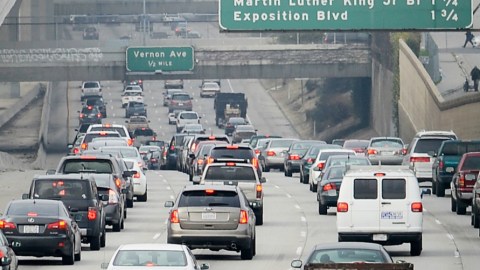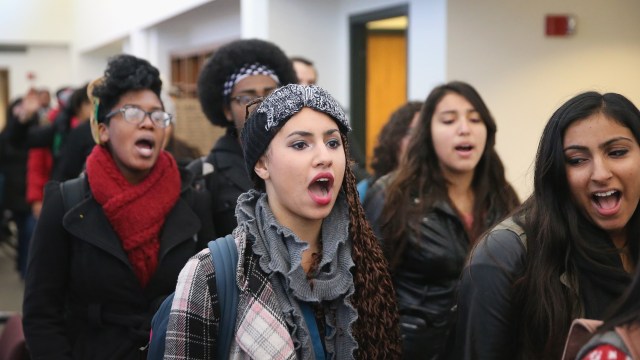Los Angeles, Automobile Mecca, Doubles Down on Bus and Bicycle Infrastructure

Los Angeles wouldn’t be Los Angeles without its trademark mind-numbingly slow traffic. For a city as well-known for its congestion as its movie stars, it’s a surprise to many people to learn that L.A. once sported one of the nation’s most extensive streetcar and rail systems. The advent of car culture put an end to all that efficiency though; during the mid-1960s the last of over 1,100 miles of track was ripped up to make way for more automobile lanes (and thus, more mind-numbingly slow traffic).
You’d be hard-pressed to find an American city more shaped by the automobile than Los Angeles. Its spider web systems of freeways are arteries connecting (and dividing) people throughout the Southland. Traffic and urban sprawl were always going to be byproducts of this culture. The city has mostly curbed the heinously unhealthy smog problem that also resulted, although it’s still a rare day to be able to see across the entirety of the basin without a gray smoky glaze getting in your way.
Over the years, city officials have tried to fix this wasteful transportation monster by investing in various public transit projects. Over 1.3 million Angelenos take advantage of Metro bus and rail each weekday, although the system itself isn’t yet much to write home about. The famous “Subway to the Sea,” first promised to residents 30 years ago and now currently under construction, is planned to terminate almost six miles from the ocean, thanks mostly to deep-rooted NIMBYism and various budgetary restraints. Metro rail’s LAX train, which runs atop the 105 freeway, doesn’t even reach the airport, necessitating a 15-minute shuttle ride in the same congestion you were hoping to avoid. The L.A. Metro is a textbook “convenient for some, not worth the trouble for most” system.
All that said, it remains a top priority for the mayor and city council to find solutions to foundational transit problems. The status quo is one rife with pollution, wastefulness, inefficiency, and high traffic fatality rates. Car culture has been good to the City of Angels in many ways, but it’s all come at a staggering cost.
With this in mind, city leaders tasked with carving out L.A. transportation policy for the coming generation have pushed through an ambitious plan that will prioritize bicycle and bus infrastructure while controversially deprioritizing automobiles. David Zahniser of the Los Angeles Timesreports:
“Known as Mobility Plan 2035, the plan spells out hundreds of miles of new bicycle lanes, bus-only lanes, and other road redesigns. It also seeks to cut the fatality rate from traffic collisions to zero within 20 years, in part by keeping cars within the speed limits. And it builds on other changes the city has already made to its streets in recent years …
… City leaders say the plan reflects a newfound view that simply widening streets is no longer feasible or, in many cases, desirable. They contend that if even a small share of motorists change their travel behavior, choosing alternatives to the car, the city can make a big dent in the overall number of miles traveled.“
We’re seeing a growing trend of cities moving to better accommodatebicycle commuters, modifying streets and sectioning off lanes to keep them safe from killer cars. Los Angeles’ plan also strives to protect pedestrians, who made up one-third of overall road deaths in the city from 2012 to 2013 despite being involved in only 10 percent of accidents. Safety is at the core of the plan. The diversification of transit options is somewhere in the crust. Nearly 240 miles of bus-only lanes would be installed in order to give residents that extra incentive to leave the auto at home.
One key downside to Mobility Plan 2035 (aside from its unimaginative moniker) is its net negative environmental impact. The council likes to think reducing space for cars will encourage fewer people to drive, yet projections indicate congestion should only get worse, at least in the short term. They hope the entrenched transportation inertia that has plagued the City of Angels for 50 years will slowly erode as streets evolve. Couple this with the increased popularity of smart growth in local urban planning and city leaders might be setting course for a better future on L.A. roads.
There’s a big difference between “might be” and “will be,” though.
It’s not going to be easy riding quite yet. Legal challenges will mount. Angry constituents who are set to see traffic grow in their neighborhoods will fight city leaders with elevated gusto. For a city so attuned to liberal values and environmentalism, most Angelenos draw the line at auto restrictions.
And in many ways, they’ve got every right.
The city remains difficult to traverse without a car. All the smart growth and bike lanes and bus infrastructure in the world isn’t going to change that. Targeting commuters is key to success but there’s only so far one can expect any progressive transit policy to go.
The fact of the matter is that grandma lives in Marina Del Rey; Uncle Phil lives in Whittier; Aunt Joyce lives in Eagle Rock; and there’s no way in hell mom and dad are taking three kids on a convoluted three-hour-long bus ride to see any of them.
L.A.’s transit plan is ambitious, yes, and it could eventually turn the course for the inner reaches of the city. But it seems L.A. is way too L.A. for anything to change any time soon. Evolution in transit, as with biology, occurs at a mind-numbingly slow pace.
Read more at the LA Times.
Below, economist Lawrence H. Summers extols the many virtues of large-scale infrastructure investment. It just makes sense:
Photo: LOS ANGELES, CA – FEBRUARY 05, 2013: Traffic on the northbound and southbound lanes of the 110 Harbor Freeway starts to stack up during rush hour traffic on February 5, 2013 in Los Angeles, United States. According to a report, traffic congestion was the second-worst in the country in the greater Los Angeles area. An average commuter spent 61 hours delayed in traffic during 2011. The cost of the wasted time and gas is about $1,300 per commuter according to a report. (Photo by Kevork Djansezian/Getty Images)





